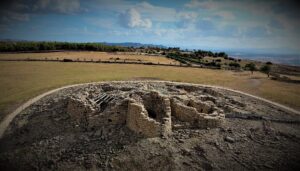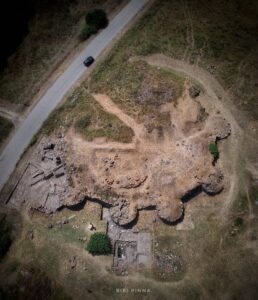Understanding what functions the nuraghi served during the long period of their use is probably the main and still unresolved question that often fuels debates, involving professionals in the field as well as simple enthusiasts. Unraveling this mystery is essential if one considers that it is precisely the “nuraghe” that is the defining element of the Bronze Age civilization and in other ways the most evident “uniqueness” characterizing the territory of the island. The opinions expressed on this matter, from the oldest to the most recent, are varied and often inconsistent with each other, but all deserving of respect. One of the most qualified hypotheses comes in particular from the archaeologist Giovanni Ugas, who in his latest substantial publication, rich in interesting observations and numerous bibliographic references, shares his personal beliefs, which moreover reaffirm the theses that the same scholar has always supported. From his book “Shardana e Sardegna” we have extracted an interesting passage included in the chapter titled “The Tribal Structure” (for brevity, references to observations and bibliographic references have been omitted):
From his book “Shardana e Sardegna” we have extracted an interesting passage included in the chapter titled “The Tribal Structure” (for brevity, references to observations and bibliographic references have been omitted): “Despite the systematic use of collective tombs leading to the belief in patriarchal communities without social inequalities, the absence of protective walls in the villages and the different articulation and grandeur of the nuraghi are signs of a hierarchized society dominated by leaders. Necessarily, the nuraghi equipped with an outer enclosure and defended by a garrison of soldiers, that is, the palaces of the tribal chiefs, must be recognized in the residences of the “re tespiadi” Iolaioi, that is Iliesi, as handed down by Diodorus Siculus and other Greek authors. They recount 40, now 43 or 50 “re tespiadi” leading the Iolei, a number that tends to coincide with that of the nuraghi with outer towered enclosures. From the 16th-14th to the 11th century, Sardinian society was centrally administered by tribal leaders, structured hierarchically. At the top of the pyramid are the chiefs or “re” of the tribal districts residing in the nuraghi equipped with an outer enclosure.”
“Despite the systematic use of collective tombs leading to the belief in patriarchal communities without social inequalities, the absence of protective walls in the villages and the different articulation and grandeur of the nuraghi are signs of a hierarchized society dominated by leaders. Necessarily, the nuraghi equipped with an outer enclosure and defended by a garrison of soldiers, that is, the palaces of the tribal chiefs, must be recognized in the residences of the “re tespiadi” Iolaioi, that is Iliesi, as handed down by Diodorus Siculus and other Greek authors. They recount 40, now 43 or 50 “re tespiadi” leading the Iolei, a number that tends to coincide with that of the nuraghi with outer towered enclosures. From the 16th-14th to the 11th century, Sardinian society was centrally administered by tribal leaders, structured hierarchically. At the top of the pyramid are the chiefs or “re” of the tribal districts residing in the nuraghi equipped with an outer enclosure.” A garrison of at least a hundred soldiers was necessary to ensure the defense of the large fortified protonuragic residences (Su Mulinu and Biriola-Dualchi) and later, no less than two hundred warriors were essential to guarantee the safety of the tower castles of the Late Bronze Age such as Su Nuraxi di Barumini, Nuraghe Arrubiu di Orroli, and S’Uraki di San Vero. The number of over seven thousand castles and monotorri could be reached because for a remarkable period of time of 600 years, from around 1600 until about 1000 BC, the same political order persisted on the island, which provided for a systematic program of settlement and progressive expansion of the tribal territory carried out through the construction of new castles and towers and the founding of other villages. The persistence of the same political model for hundreds of years also led to the strengthening of the power of tribal leaders and probably, based on the innovations introduced in the field of funerary rituals, starting from the last decades of the 14th century, the tribal leaders themselves transformed their initially temporary position, typical of sacred kings, into a lifelong and perhaps hereditary one, as happened in Egypt for the pharaohs who extended the exercise of royalty over time, with the periodic establishment of the ritual festival “Sed” which involved the sacrifice of substitute victims and the display of proof of valor.
A garrison of at least a hundred soldiers was necessary to ensure the defense of the large fortified protonuragic residences (Su Mulinu and Biriola-Dualchi) and later, no less than two hundred warriors were essential to guarantee the safety of the tower castles of the Late Bronze Age such as Su Nuraxi di Barumini, Nuraghe Arrubiu di Orroli, and S’Uraki di San Vero. The number of over seven thousand castles and monotorri could be reached because for a remarkable period of time of 600 years, from around 1600 until about 1000 BC, the same political order persisted on the island, which provided for a systematic program of settlement and progressive expansion of the tribal territory carried out through the construction of new castles and towers and the founding of other villages. The persistence of the same political model for hundreds of years also led to the strengthening of the power of tribal leaders and probably, based on the innovations introduced in the field of funerary rituals, starting from the last decades of the 14th century, the tribal leaders themselves transformed their initially temporary position, typical of sacred kings, into a lifelong and perhaps hereditary one, as happened in Egypt for the pharaohs who extended the exercise of royalty over time, with the periodic establishment of the ritual festival “Sed” which involved the sacrifice of substitute victims and the display of proof of valor. The location of the nuraghi throughout the island, even in floodplains where large stones for construction are lacking, is an additional sign of an organized settlement system coordinated from above, centralized. Sometimes the nuraghi in the territory of San Gavino Monreale, in the Campidano plain, are found to be even ten kilometers away from the source of the stone material, and for their construction, not only a transportation system using carts and/or oxen-driven sleds was necessary, but also the initiative of a higher authority that would plan the realization of new fortified residences and make available the stone material located even in different and distant cantonal areas from where the new nuraghe was being built. Moreover, the very existence of the three distinct peoples of the Iliesi, Balari, and Corsi implies the need for political bodies capable of operating at the intertribal level both in internal relations and in relations with representatives of extrainsular institutions…
The location of the nuraghi throughout the island, even in floodplains where large stones for construction are lacking, is an additional sign of an organized settlement system coordinated from above, centralized. Sometimes the nuraghi in the territory of San Gavino Monreale, in the Campidano plain, are found to be even ten kilometers away from the source of the stone material, and for their construction, not only a transportation system using carts and/or oxen-driven sleds was necessary, but also the initiative of a higher authority that would plan the realization of new fortified residences and make available the stone material located even in different and distant cantonal areas from where the new nuraghe was being built. Moreover, the very existence of the three distinct peoples of the Iliesi, Balari, and Corsi implies the need for political bodies capable of operating at the intertribal level both in internal relations and in relations with representatives of extrainsular institutions… The photos of the nuraghi: Su Nuraxi di Barumini, Su Mulinu di Villanovafranca, Biriola di Dualchi, S’Uraki di San Vero Milis, and Arrubiu di Orroli are respectively by Valentino Selis, Antonello Gregorini, Marco Cocco, Bibi Pinna, and Sergio Melis.
The photos of the nuraghi: Su Nuraxi di Barumini, Su Mulinu di Villanovafranca, Biriola di Dualchi, S’Uraki di San Vero Milis, and Arrubiu di Orroli are respectively by Valentino Selis, Antonello Gregorini, Marco Cocco, Bibi Pinna, and Sergio Melis.

